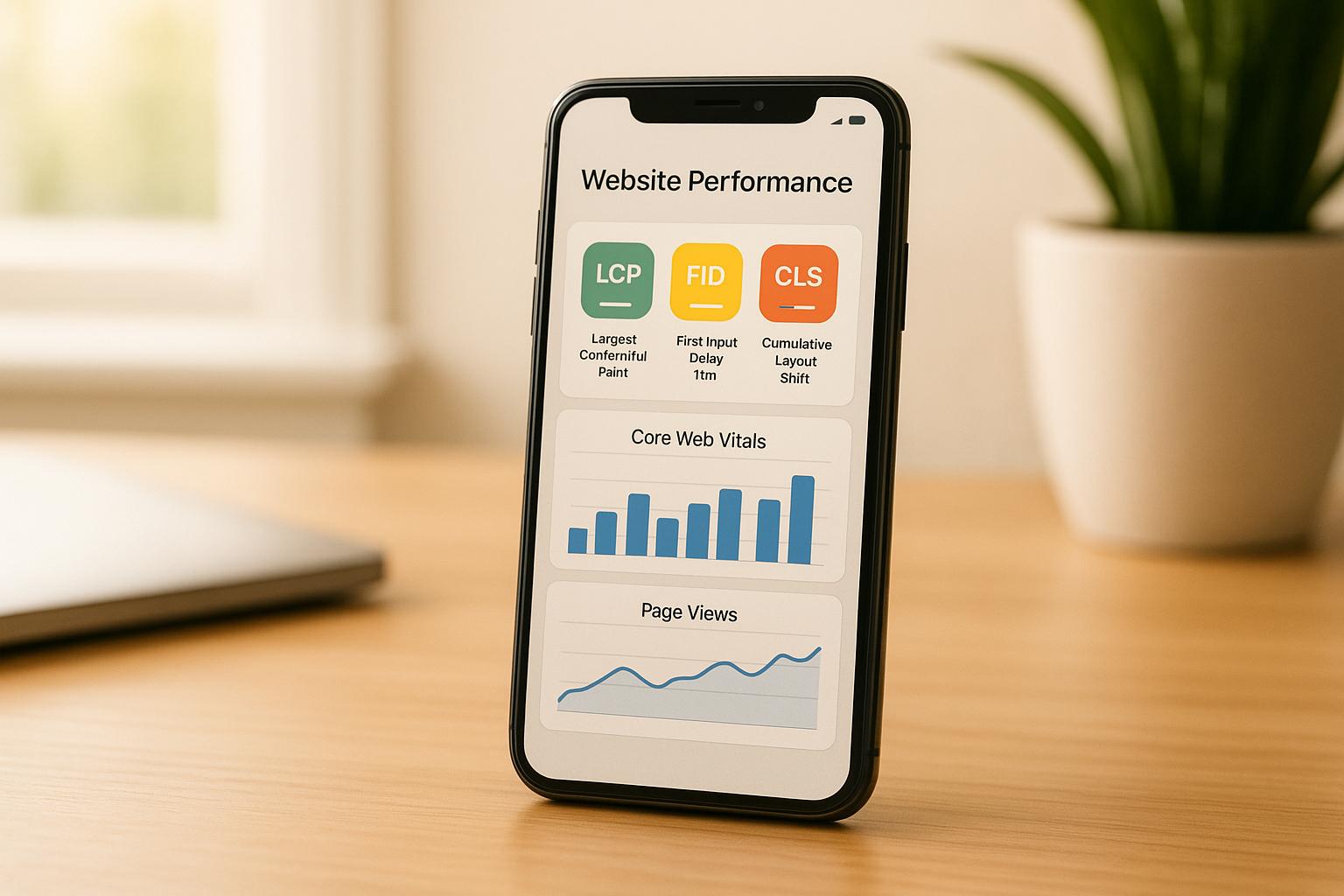Want to outperform your competitors with data-backed content strategies? Competitor content benchmarking helps you measure your performance against others using clear, measurable metrics. This approach focuses on hard data - like keyword rankings, engagement rates, and backlinks - to refine your content strategy and improve results.
Key Takeaways:
- Define Goals: Set specific, measurable objectives tied to your business priorities (e.g., increasing engagement or improving SEO rankings).
- Identify Competitors: Analyze both direct (similar products) and indirect competitors (different methods, same audience).
- Use Tools: Platforms like Ahrefs, Semrush, and Google Analytics provide actionable insights.
- Track Metrics: Focus on metrics like website traffic, conversion rates, and social shares that align with your goals.
- Review Regularly: Keep your analysis updated to stay relevant in a changing market.
Bottom Line: Competitor benchmarking isn’t about copying - it’s about learning what works, identifying gaps, and creating better content that connects with your audience.
How I use Semrush + AI for competitor analysis and SEO ideas

Set Clear Goals for Your Benchmarking
To make benchmarking effective, start by setting specific and measurable objectives. Without clear goals, you risk getting lost in irrelevant data or wasting valuable time.
"Goal setting is critical for establishing agency-client alignment. When we set goals in collaboration with our clients, it clearly outlines, 'This is what we are trying to accomplish.' It also provides a structure to determine whether our marketing efforts are successful or not." - Kerrie Luginbill, Chief Strategy Officer, OTM
Define Specific Goals
Your goals should be precise and directly tied to the areas that influence your organization's performance. Vague objectives like "improve content performance" won't give you the clarity you need to act. Instead, focus on outcomes you can measure - like increasing engagement, identifying content gaps, or improving specific SEO metrics.
For example, if you aim to boost engagement, track metrics like time on page, social shares, or comment rates. If SEO is your focus, monitor keyword rankings, organic traffic, and backlinks. Each goal should have a clear timeline and measurable benchmarks to assess progress effectively.
It's also critical to identify weaknesses in your current strategy. Are you struggling with low social media engagement? Poor lead generation? Weak search rankings? These challenges should guide the goals you set, ensuring your efforts address the most pressing issues.
Match Goals with Business Priorities
Your benchmarking goals should align with your overall marketing strategy to ensure they contribute to meaningful business outcomes. Start by defining your business priorities - whether it's lead generation, brand awareness, or sales conversions - and directly link these to your benchmarking targets.
For example:
- If lead generation is your priority, focus on metrics like conversion rates and email sign-ups.
- If brand awareness is your goal, track brand mentions, share of voice, and audience reach.
Understanding who you're benchmarking against is just as important. Identifying your direct competitors and their relevance to your success helps you set realistic expectations and choose meaningful comparison points.
By aligning your goals with business priorities and selecting relevant KPIs, you stay focused on competitor activities that truly matter. This also makes it easier to communicate the value of your benchmarking efforts to stakeholders, ensuring everyone is on the same page.
Next, take the time to identify the competitors that best reflect your business challenges.
Choose the Right Competitors to Benchmark
After setting your goals, the next step is identifying the right competitors to benchmark against. Choosing wisely ensures your performance data is meaningful and actionable. By focusing on competitors that align with your market, you set the stage for effective analysis and strategy development.
It’s important to include both direct competitors - those offering similar products to the same audience - and indirect competitors, who tackle the same customer problems in different ways. This mix gives you a well-rounded view of your competitive landscape and can uncover opportunities you might not have considered.
Pick Direct and Indirect Competitors
Direct competitors are businesses targeting the same audience with similar products or services, often at comparable price points. These are the competitors you’re likely already aware of, but identifying them can require more than a surface-level look at your industry.
A simple yet effective method is to manually search your primary keywords and see which domains dominate the rankings. For instance, searching "travel miles guide" reveals sites like Upgraded Points, Daily Drop, and The Points Guy as direct competitors because they all cater to budget-conscious travelers.
Don’t just focus on the top-ranking competitors, though. As Kristavja Caci, SEO Content Marketer at Surfer, points out:
"Don't just go after who ranks #1. Sometimes your most valuable insights come from competitors one tier below - that's where real opportunity lives."
This approach can help you uncover more realistic opportunities and strategies that you can actually implement.
Indirect competitors, on the other hand, solve similar problems but through alternative methods. For example, in transportation, ride-sharing apps like Uber and Lyft compete indirectly with public transit and taxis. In the music world, streaming platforms like Spotify and Apple Music have reshaped how people consume music, competing with traditional album sales and downloads.
Including indirect competitors in your analysis broadens your perspective. A coffee shop, for instance, could benchmark against a juice bar since both appeal to health-conscious consumers. These comparisons can highlight innovative strategies for engaging audiences or differentiating your brand.
When evaluating potential competitors, consider their product offerings, brand reputation, and target audience. Make sure the competitors you choose have accessible and measurable data that you can analyze effectively.
Use Research Tools
While manual research is valuable, specialized tools can take your competitive analysis to the next level, offering deeper insights and saving time. These tools can help you identify competitors you might have overlooked and provide detailed performance data for benchmarking.
Start with free Google tools for a solid foundation. Google Search Console lets you explore competitor domains and see which queries they rank for. Google Trends highlights trending topics and queries in your niche. Google Analytics Auction Insight Reports provide insights into competitor ad performance, while Google Merchant Center allows you to compare product pricing. You can even set up Google News alerts to stay updated on competitor activity.
For more advanced analysis, paid tools can be game-changers. Ahrefs is a popular choice for SEO, offering robust keyword and backlink data. Ben Poulton, SEO consultant and founder of Intellar, shares:
"Ahrefs is my go-to software for SEO, and their functionalities for competitor analyses are super helpful right out of the gate. I can create detailed reports on competitive benchmarking by keyword and category. These help me and clients quickly spot gaps, underperforming areas, or highly competitive terms we do well on, but want to make sure we maintain."
Semrush provides an all-in-one solution for SEO, social listening, and market intelligence. Similarweb, which processes billions of data signals daily, offers insights into sales and marketing trends.
Social media monitoring tools like Sprout Social are also invaluable. They track competitor performance across platforms, as Simon Bacher, CEO and co-founder of Ling, explains:
"Sprout Social allows us to monitor brand mentions, hashtags, keywords, and more across various platforms. It helps us gain insight into how consumers perceive our and competitors' brands."
Owler, with its free and paid plans, is another cost-effective option for competitor profiling and monitoring.
When selecting tools, focus on metrics that matter. Pay attention to how often competitors post, the balance between promotional and non-promotional content, and their top-performing keywords and hashtags. Your choice of tools should align with your specific needs, how you plan to use the data, and your budget.
Once you’ve identified your competitors and equipped yourself with the right tools, the next step is to pinpoint the metrics that will shape your content strategy.
Pick and Track Key Performance Metrics
Once you've identified competitors and gathered the necessary tools, the next step is to zero in on the metrics that align with your business goals. Prioritize metrics that genuinely impact your objectives - not just those that look impressive on paper but fail to drive meaningful progress.
For content marketing, focus on metrics tied to goals like engagement, website traffic, and conversions. These metrics provide actionable insights, helping you understand not just what’s happening, but why it’s happening.
As Sunil Gupta, a Harvard Business School Professor, points out:
"It isn't enough to measure the final outcome alone. You also need to track intermediate metrics to understand where consumers might be getting stuck - essentially bottlenecks in the marketing funnel."
This mindset allows you to identify problem areas and refine your strategy for better results.
Choose Relevant Metrics
The metrics you track should directly reflect your content marketing goals, which often fall into four main categories: brand awareness, engagement, lead generation, and customer retention. Each category requires specific measurements to evaluate success effectively.
- Brand awareness: Metrics like website visits, social media engagement, and newsletter sign-ups indicate whether your content is reaching new audiences and introducing them to your brand.
- Engagement: Time on page, bounce rates, social shares, and comments show how well your audience interacts with your content.
- Lead generation: Track leads generated from content, conversion rates on landing pages, form submissions, and content downloads to measure how effectively your content turns viewers into potential customers.
- Customer retention: Metrics like repeat customer percentage, churn rate, and time between visits help gauge loyalty and ongoing engagement.
Here’s a quick overview:
| KPI Category | Example Metrics | Purpose |
|---|---|---|
| Brand Awareness | Website visits, social media engagement, newsletter sign-ups | Measures how well your content increases brand recognition |
| Engagement | Time on page, bounce rate, social shares, comments | Shows how audiences interact with your content |
| Lead Generation | Number of leads, conversion rates, form submissions | Tracks how well your content converts viewers into potential customers |
| Customer Retention | Repeat customer percentage, churn rate, time between visits | Indicates loyalty and ongoing engagement |
Don’t overlook the value of email campaign data. Metrics like click-through rates and open rates can offer additional insights, especially when compared to industry averages.
Keep It Simple
Tracking too many metrics can overwhelm your team and dilute your focus. The best content marketers hone in on a handful of key metrics that directly influence their goals.
Kayla Voigt, CEO of KL Voigt Writing Co., highlights this approach:
"The most important metric should be the one that measures the success of your goals."
Tom Bangay, Director of Content at Juro, takes it a step further:
"The one metric my team and I prioritize above all others is revenue, and I make sure our bonuses are tied to it, because if you can't prove that your content is influencing revenue in an attributable way, then you're probably doing the wrong things anyway."
Stick to 3–5 core metrics that are actionable - meaning you can take specific steps to improve them. For example, if your bounce rates are high, consider refining your content format, improving page load speeds, or better aligning your content with user search intent.
Leverage tools like Google Analytics to track website visits, engagement, and conversions. Use your email marketing platform for detailed campaign data, and tap into social media analytics to monitor shares, comments, and reach.
Finally, schedule regular reviews to ensure your chosen metrics stay relevant as your business grows or shifts focus. Metrics that matter in your early stages might evolve as you expand or enter new markets. Keeping your measurement strategy adaptable ensures you stay aligned with your goals. Up next, learn how to use these metrics to analyze data and foster collaboration across teams.
sbb-itb-5be333f
Use Reliable Tools and Resources
The right tools can make or break your efforts when it comes to benchmarking competitor content. By choosing platforms that provide accurate, ethical data and align with your goals, you can streamline your process and make smarter decisions. Below, we’ll explore how analytics platforms and curated directories can help you stay ahead.
When evaluating tools, focus on options that offer detailed metrics, social listening features, and clear data visualization. A user-friendly interface is key - it should make complex data easy to understand and act on. Also, ensure the tools integrate seamlessly with your existing tech stack to encourage team adoption and collaboration.
Use Analytics Platforms
Professional analytics platforms are your go-to for gathering competitor data efficiently and ethically. These tools rely on publicly available information, keeping you within legal and ethical boundaries while delivering valuable insights.
Look for platforms with features like historical data tracking, comprehensive social media coverage, and advanced reporting capabilities. Social listening and sentiment analysis are especially useful for understanding not just what your competitors are posting, but how their audience reacts. This added layer of insight helps you refine your own strategies.
Trusted tools like SEMrush and Ahrefs are industry standards for competitor analysis. They offer reliable data and robust security measures to protect your information.
"Believing that your competition is stronger and better than you pushes you to better yourself".
To make the most of these tools, take advantage of free trials and demos. Involve your team during the selection process - those who will use the tools daily can provide valuable feedback on usability and features. This hands-on approach ensures you pick a platform that works for everyone.
Check the Top SEO Marketing Directory
For even more options, explore curated resources like the Top SEO Marketing Directory. This directory highlights the best tools and services for content benchmarking, from keyword research to competitor tracking. It’s a one-stop shop for discovering specialized solutions tailored to your needs.
The directory includes top-rated SEO agencies and software providers, offering tools for everything from technical SEO audits to content optimization. Whether you’re looking for basic tools or comprehensive platforms, this resource simplifies the search by focusing on quality over quantity. Instead of overwhelming you with endless choices, it narrows down the best options, saving you time and effort.
Analyze Data and Share Results
Once you've gathered your data, the next step is to dig into it and turn those numbers into something meaningful. Data, by itself, doesn’t do much - it’s the insights and comparisons you draw from it that truly matter. This process is the foundation for better decision-making and collaboration within your team.
Your benchmarking efforts only make an impact when you transform raw data into clear, actionable insights. By identifying what’s working and what isn’t, you set the stage for smarter content strategies.
Document and Compare Data
Start by organizing the data you’ve collected from competitors. Laying it out in a way that makes patterns and trends obvious can help you pinpoint performance gaps and areas for growth. Side-by-side comparisons work well for this, as they highlight differences and opportunities.
Dive deeper into your competitors' strategies and engagement trends. For instance, entertainment brands on TikTok often use memes, GIFs, and viral moments, proving that short, humor-driven content resonates strongly on that platform. Observing these patterns can help you refine your approach.
Timing and context also play a big role in uncovering trends. High-quality, timely content often outperforms high-volume posting strategies. Use charts or tables to make key differences stand out. Highlight your biggest gaps and your competitors’ most effective tactics - this analysis becomes your roadmap for fine-tuning your strategy.
Once you’ve outlined these comparisons, share your findings with your team to kickstart collaboration.
Work with Your Teams
Clear communication is the bridge between analysis and action. Once you’ve laid out your data comparisons, tailor your findings to fit the needs of different groups, like content teams, executives, or marketing managers. Each audience will require a different level of detail and context.
Start by defining the purpose of your communication and who you’re addressing. Then, adjust your tone, format, and level of detail to match their needs. For example, use data visualization and storytelling techniques to make your findings more engaging. Instead of overwhelming your team with raw numbers, focus on the strategic takeaways - like how competitor insights can sharpen your content plans, improve ad spending, or enhance the customer experience.
Be sure to present a balanced view. Highlight both strengths and weaknesses, and point out opportunities where your team can close gaps or outperform competitors . This approach builds trust and gives everyone a clear picture of the competitive landscape.
It’s also important to anticipate pushback. Some team members may question your findings or resist changes to established processes. Prepare data-backed arguments and concrete examples to address their concerns.
Finally, end your presentation with clear next steps. Propose a plan that outlines responsibilities, sets deadlines, and establishes a process for tracking progress. This ensures your benchmarking efforts lead to meaningful, strategic improvements.
Review and Update Your Benchmarking Process
Once you've analyzed your data and collaborated with your team, it's vital to keep your benchmarking process up to date. Competitor content benchmarking isn't a one-and-done task - it’s an ongoing effort. Without regular updates, you risk making decisions based on outdated information, which can lead to missed opportunities or ineffective strategies.
The marketplace is constantly evolving. What worked a few months ago might not work today. Regular reviews ensure your data stays relevant and that your strategies remain aligned with current conditions. This ongoing process connects your data analysis efforts to actionable changes in your approach.
Schedule Regular Reviews
How often you review your benchmarks depends on the pace of your industry. For industries like social media, e-commerce, or technology - where trends shift quickly - monthly reviews are ideal. In slower-moving industries, quarterly reviews might be sufficient.
"Set up monthly or quarterly benchmarking reviews to assess whether the changes have had the desired impact and adjust your strategy accordingly." – Therese Nguyen, Former Marketing Manager turned Freelance Content Writer
Proactive Worldwide, Inc. advises conducting quarterly competitive analyses as a baseline, with monthly reviews for industries that demand quicker responses. This approach helps you spot trends early, giving you time to adjust before your competitors outpace you.
When conducting these reviews, focus on identifying major shifts in your competitive environment. For example, has a competitor started dominating search results for your target keywords? Are they experimenting with new content types that are gaining traction? These changes often signal broader market trends that may require immediate action.
The key here is consistency. Treat these review dates as fixed appointments on your calendar. Regular monitoring and adaptation are critical for maintaining an edge in today’s fast-changing digital landscape.
"Businesses should regularly review benchmarks, track progress, and adapt to industry changes to maintain competitiveness and drive long-term success." – Judhajit Sen, Author
Update Metrics and Competitor Lists
After each review, take the time to update your metrics and competitor lists so they reflect current realities. This step ensures your benchmarking efforts stay relevant and aligned with your business goals.
Refreshing your competitor list is an ongoing task. As new players enter the market or existing competitors shift their strategies, you need to adjust your list to include the most relevant brands. A well-rounded list should include reach competitors (those you aim to emulate), immediate competitors (your direct rivals), and offline competitors who are entering the digital space.
When it comes to metrics, ask yourself if your current measurements still align with your goals. Early on, you may have focused on basic engagement metrics, but as your business evolves, you might need to prioritize more advanced indicators like organic share of voice, domain authority, or conversion rates. Metrics that once seemed critical may no longer be as impactful.
Automation tools can make this process much easier. Platforms like Google Data Studio can help you streamline updates and ensure your data remains accurate.
"Competitive benchmarking analysis should be highly curated and scrutinized to avoid undershooting or overpromising from benchmarking against the wrong competitor."
Conclusion: Success Through Competitor Content Benchmarking
Competitor content benchmarking offers a clear path to staying ahead in a competitive market. By making decisions based on solid data, you can drive meaningful growth and keep your strategies sharp. This approach ensures you're always improving and adapting.
One of the biggest risks of ignoring competitor data is complacency. As Jack Welch, former CEO of General Electric, wisely put it:
"If you don't know what your competitors are doing, you're flying blind."
Benchmarking isn't a one-and-done task - it's an ongoing process. The market is constantly shifting, and your analysis methods, competitor lists, and metrics need to evolve with it. Ben Tutt, Head of Market Insights at BAE Systems, highlights this reality:
"There is no such thing as a static, perfect database of Competitive Intelligence, it doesn't work like that."
The real value of benchmarking comes when you turn insights into action. Whether it's refining your strategies, tweaking campaigns, or improving your products, these adjustments can make a measurable difference. Regularly revisit your metrics and review schedule to ensure your efforts stay aligned with your goals.
As digital marketing tools and techniques grow more advanced, the potential for benchmarking expands too. By staying up to date with the latest tools and committing to consistent reviews, you can build a competitive edge that strengthens over time.
Start incorporating these practices into your routine today. Let data-driven insights take your content strategy from reactive to proactive, setting the stage for long-term success.
FAQs
How do I identify the best competitors to benchmark for my content strategy?
To find the right competitors for benchmarking, look for businesses within your niche that cater to a similar audience and share comparable goals or business models. It's smart to focus on competitors who are a step ahead in the market. Their strategies can offer practical ideas to help you improve and grow.
Pay attention to details like their target audience, marketing methods, and the products or services they offer. This approach ensures your comparisons stay relevant and useful, giving you clear direction to fine-tune your content strategy.
What key metrics should I track to benchmark competitor content effectively?
To effectively analyze competitor content, keep an eye on these key performance metrics:
- SEO rankings: See how well their content is showing up in search engine results.
- Backlinks: Look at the quantity and quality of links pointing to their pages.
- Engagement metrics: Track likes, shares, comments, and other interactions on social media.
- Conversion rates: Assess how effectively their content encourages user actions, like sign-ups or purchases.
- Customer sentiment: Understand how their audience feels about their content and brand.
By diving into these metrics, you can uncover your competitors' strategies and pinpoint ways to enhance your own content game.
How often should I review and update my competitor content benchmarking process?
To keep your benchmarking process on point, make it a habit to review and refresh it at least once a year. If you're in a fast-moving industry or your content strategy shifts often, you might want to revisit it more frequently - quarterly or every six months could be a smarter choice.
By updating regularly, you ensure your benchmarks stay aligned with current trends and keep you ahead in the ever-changing landscape of content strategy.


